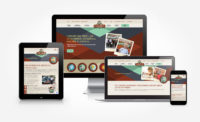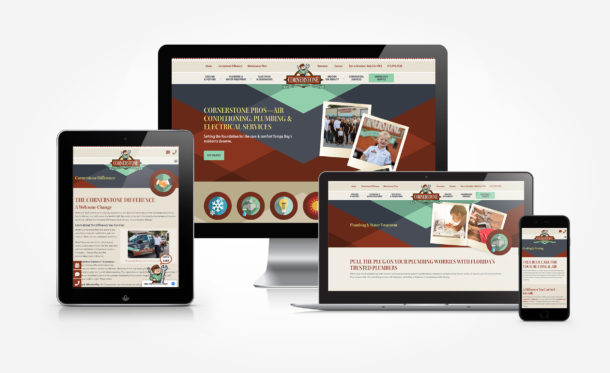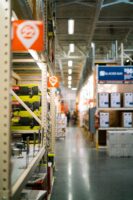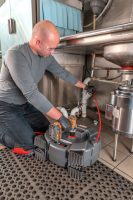Often, plumbing businesses go under the radar when it comes to online marketing, perhaps they have an established offline brand already, or they don’t have the technical skills to build an effective website and marketing campaign, but doing so can grow a local business quickly. Below you can find five tips on where to start Read more
Whats New

Often, plumbing businesses go under the radar when it comes to online marketing, perhaps they have an established offline brand already, or they don’t have the technical skills to build an effective website and marketing campaign, but doing so can grow a local business quickly. Below you can find five tips on where to start with online marketing for your plumbing business.
Get Professional Help
If nothing is working, and you are not seeing the results that you are hoping for, then you need to enlist the help of a professional. There are independent marketing consultants that you can hire to help you with your marketing, or you can look into someone like Top Marketing Agency who can provide you with the marketing services to boost your business. It’s entirely down to you which of these options is going to suit your business best, but professional help is always a good choice for your marketing. At the very least, these people keep up with new marketing trends so that you don’t have to.

Google Business Profile
When marketing any business online, you have to think like a customer; if someone in your local area needs a plumbing service, the first thing they are likely to do is to go online and search for plumbing services near me. In these circumstances, you want your plumbing service to appear.
Claiming your Google business listing is very straightforward, and it helps the search engine algorithm to make your business more visible on search engine results. Simply find your business on Google Maps, click on it, and press click Claim this Business, or Manage Now.
Build a Plumbing Brand
If you want your plumbing business to flourish online, it’s a good idea to build an effective brand. Branding is a way to focus your business and create an image that customers recognize and trust for the right reasons. Start by thinking about your services, the local area, and your values.
Build your plumbing brand from the inside out, and you can feel confident that the company’s self-image has integrity. When you have created the value system for the business, start thinking about the logo, colors, and slogan. The brand should be visible and consistent in the business.
Build an Effective Website
Making a website for your business means more than having an online presence; your website needs to accomplish a myriad of tasks; it also needs to be designed in the right way so that customers can find you easily through the search engine and you can market your services.
There’s no reason why you can’t create a website yourself, but it probably won’t have the same form and functionality as one designed by Red Spot Design. Professionally designed websites are ten times more effective, and although they cost money upfront, they save time and hassle.
Use Google Ads
There are two ways to make yourself visible to customers on search engines, one of them is to create a professional website and produce quality plumbing content regularly to help you to move up the organic search results. The other is to invest in Google ads a go straight to the top.
Google ads take you to the top of the search results page without having to create lots of content; simply create your ad on their website and set your marketing budget; you will only pay when an ad is clicked. They are perfect advertising for people that need an emergency plumber.
Use Email Marketing
When someone interacts with your website or offline business, try to acquire their email address which can be very useful for email marketing campaigns. These campaigns send emails with information with offers and discounts for your services. Acquire emails with gated content online.
Making your employees happy should be a top priority for any business owner. After all, they are the lifeblood of your company! If you want to keep them motivated and productive, you need to make sure that your work environment is pleasant and comfortable. In this blog post, we will discuss four additions that you Read more
Making your employees happy should be a top priority for any business owner. After all, they are the lifeblood of your company! If you want to keep them motivated and productive, you need to make sure that your work environment is pleasant and comfortable. In this blog post, we will discuss four additions that you can make to your business building in order to improve the working conditions for your employees.
A Comfortable Break Room
A place where employees can relax and take a break from their work is a must-have in any business building. Make sure that your break room is furnished with comfortable furniture and has enough space for everyone to enjoy. If you don’t have a dedicated break room, consider setting up an area in the office where employees can take breaks. This can be a small corner with a few chairs and a coffee machine or even just a couple of bean bags in a quiet area. Employees will appreciate having somewhere to unwind during their workday. And speaking of coffee machines, make sure that your office has one! Coffee is essential for many people’s productivity, so make it available and convenient for your employees.

Natural Light
Natural light is important for people’s health and well-being, so try to incorporate it into your office space as much as possible. If you have a window in your office, make sure that there is no obstruction blocking the light. If you don’t have any windows, consider installing some skylights or bringing in some plants that can absorb natural light. Your employees will appreciate being able to work in a bright and airy space. And studies have shown that natural light can improve productivity, so it’s a win-win for everyone!
HVAC System
A good HVAC system is crucial for a comfortable work environment. Make sure that your office building has a high-quality system that can keep the temperature and humidity at a comfortable level. This will ensure that your employees are not too hot or too cold and that they don’t have to deal with any stuffiness. Your HVAC system should be serviced regularly to ensure that it is working properly. And if you live in an area with extreme temperatures, consider investing in a backup system in case of power outages or other problems. Make sure that the HVAC services your business needs are taken care of so that your employees can be comfortable at work. Your employees will thank you for a comfortable work environment, and they will be more productive as well!
Quiet Areas
Not everyone enjoys working in a noisy environment. Some people need some peace and quiet in order to focus on their work. If you have employees who prefer to work in silence, make sure that there are some quiet areas in your office where they can go. This can be a small room with soundproof walls or just an area away from the main work area where people can go to concentrate. Employees will appreciate having somewhere to escape the noise when they need to get some work done. And if you have employees who do enjoy working in a more lively environment, make sure that there is also space for them to do so! A mix of both quiet and loud areas will accommodate everyone’s needs and preferences.
There are many things that you can do to make your office more comfortable for your employees. By taking some simple steps, you can create a working environment that is pleasant and productive. Your employees will thank you for it!

When buying new construction materials or renovating an existing structure, there are many factors to consider before the first nail is struck. How will your home stand up to the weather? What type of insulation is right for you? Which roofing material is best? These questions can make the construction process seem overwhelming, but it Read more
When buying new construction materials or renovating an existing structure, there are many factors to consider before the first nail is struck. How will your home stand up to the weather? What type of insulation is right for you? Which roofing material is best? These questions can make the construction process seem overwhelming, but it doesn’t have to be. With the correct information, you can pick the perfect materials for your home no matter where you live. There are plenty of considerations when choosing new building materials that extend beyond cost and availability. Your area’s climate affects which materials will perform best and last longest. For example, a home in a humid area won’t last as long if it’s built with cedar siding or redwood in its walls because those woods are known to expand and contract with humidity changes. Knowing what challenges different climates present with unique construction materials is essential before beginning any project.

Climate-Based Building Material Guide
When choosing building materials, it’s vital to consider the climate where the building will be located. For example, is your area prone to floods, hurricanes, wildfires, or tornadoes? Some materials are better suited to each of these types of climates.
In these flood-prone areas, you’ll want to avoid any kind of wood for framing, flooring, and siding. Instead, go with concrete, stone, or brick. Whereas to survive storms, you’ll want to avoid low-lying areas that are prone to flooding. Instead, choose higher ground that avoids flooding or is built up enough to prevent flooding. For building materials, go with concrete and steel. You want to be careful with building materials that could create sparks in places prone to wildfires. Wood, fabrics, and types of vinyl can create sparks during wildfires and should be avoided. Instead, be sure to choose concrete, stone, or metal. Lastly, buildings that are prepared for tornadoes are built with reinforced concrete and steel, with tanks built underground to withstand high-velocity winds.
Wood Materials for Every Climate
Cedar is good for humid areas because it doesn’t expand or contract with humidity changes. However, it’s more expensive than other woods like redwood and pine. Cedar is also great for siding, decks, and fences. It’s very durable and can be treated with a sealant to protect against rot, insects, and water damage. Cedar is one of the best wood building materials for high humidity areas. It resists warping and rotting. It’s strong enough for outdoor use but isn’t as heavy as other hardwoods. It has a classic look and is easy to work with. It lasts for decades with minimal maintenance.
Redwood is suitable for outdoor use but isn’t great for high humidity areas because it expands and contracts with humidity changes. It’s softwood and isn’t as durable as other woods like cedar or pine. Redwood is best used for indoor projects like paneling, shelving, and cabinets. It’s great for painting, staining, and finishing. Redwood is one of the best wood building materials for temperate areas. It’s strong enough for outdoor use and lasts decades with minimal maintenance.
Concrete and Brick Materials for Every Climate
Concrete is a durable material that can be used for indoor or outdoor projects. It’s suitable for high humidity areas because it doesn’t warp, expand, or contract with humidity. Concrete is one of the best materials for foundations and basements because it’s mold-resistant, water-resistant, and durable. It’s also good for sidewalks, driveways, and walls. Concrete is one of the best materials for high-humidity areas. It’s strong and durable. It lasts decades with minimal maintenance.
Brick is another good material for high-humidity areas. It’s strong and lasts decades with minimal maintenance. It’s not great for outdoor use unless it’s covered in concrete. Brick is good for indoor projects like fireplaces, walls, and walkways. It’s great for patios and outdoor walkways because it’s durable and looks great. Brick is one of the best materials for humid areas. It’s strong, durable, and lasts for decades with minimal maintenance.
Metal Materials for Every Climate
Steel is a strong building material that’s used for frames and roofs. It’s great for high-humidity areas because it doesn’t warp, expand, or contract with humidity. Steel is common for roofing because it’s strong but lightweight. It’s also suitable for building and framing. Steel is one of the best materials for high-humidity areas. It’s strong and lasts decades with minimal maintenance. Steel is one of the best materials for high-humidity areas. It’s strong and lasts decades with minimal repairs required.
Aluminum is another good metal building material. It’s lightweight but strong and good for high-humidity areas. It doesn’t warp or expand or contract with humidity. Aluminum is great for siding and roofing. It’s strong, lightweight, and lasts decades with minimal maintenance. Aluminum is one of the best materials for high-humidity areas. It’s strong and lasts decades with minimal maintenance.
Roofing Options for Every Climate
Asphalt shingles are a popular choice for roofs. They resist wind, hail, and fire. However, they don’t last as long in high-humidity areas because they warp and expand with humidity changes. Asphalt shingles are a good option for low- to moderate-humidity sites. They’re durable and last 25-40 years with minimal maintenance. Asphalt shingles are one of the best materials for low-humidity areas. They’re solid and last decades with minimal upkeep needed. In addition, they’re affordable, easy to install and come in various colors.
Concrete roofing is a high-end material that lasts a long time. It doesn’t warp or expand or contract with humidity. Concrete roofing is a good option for high-humidity areas. It lasts decades with minimal maintenance. Concrete roofing is one of the best materials for high-humidity areas. It’s strong and lasts decades with minimal maintenance. Metal Roofing: Metal roofing is durable and lasts a long time. It doesn’t warp or expand or contract with humidity. Metal roofing is a good option for high-humidity areas. It lasts decades with minimal maintenance. Metal roofing is one of the best materials for high-humidity areas. It’s strong and lasts decades with few repairs to upkeep.
Conclusion
The building supplies you choose will significantly impact the performance of your new home or renovation. They’ll be the first line of defense against the elements, so it’s essential to choose wisely. Choosing suitable materials is tricky since there are so many factors to consider. Hopefully, this guide has helped you find the best materials for your particular climate.

Most people reading the title of this post would no doubt answer its proposed question with, “well, hire emergency plumbers,” and they’d be completely right. This is step one in the process of resolving a fault, and many of these firms can call out immediately to rectify the issue or help you limit the damage Read more
Most people reading the title of this post would no doubt answer its proposed question with, “well, hire emergency plumbers,” and they’d be completely right. This is step one in the process of resolving a fault, and many of these firms can call out immediately to rectify the issue or help you limit the damage before they arrive; such as by turning off the water mains so leaks don’t spread too far.
That said, plumbing issues may not always simply require a quick fix to solve. In some circumstances, an issue like this can need weeks of renovation and repair in order to not only resolve the issue, but to ensure it won’t happen again. It’s always best to implement a direct solution now, no matter how long that takes, than to integrate patchwork fixes that only delay the inevitable.
But what exactly should you do if your business premises suffer a plumbing issue? In this post, we hope to discuss that, as well as how to manage your staff appropriately during this time:

Immediate Callout
Of course, ensuring that the chance for an immediate callout is one you can rely on makes a big difference. This may be the difference between a leak causing some damage or a lot of damage. They will be able to advise how to properly implement fixes in the right way; such as by renovating the plumbing network, replacing fixtures, or assessing the cause of damage. In the long run, these services are worth paying long-form maintenance subscription charges for, because they can save you thousands in recuperative costs after the fact.
Alternate Arrangements
It’s also important to make alternate arrangements as and when you can do so, especially if you have staff to manage. Portable toilets will provide a worthwhile method of giving staff somewhere to capably and hygienically retire when needed. It may also mean that events and other important calendar events can go ahead despite the difficulties with plumbing and the week-long fixes they require. Alternatively, it might be worth simply sending certain staff members home for the time being as you may not have the required about of legal restrooms necessary for them, luckily hybrid and remote working can make a big difference here.
Fencing Off Problem Areas
Of course, safety is paramount. A singular plumbing problem of sufficient difficulty can sometimes leave the overall structural soundness of an area incompatible with adequate risk management, which means that fencing off problem areas is key. Positioning signs to showcase where work will be carried out and which alternative routes exist can help those in your building more easily commit to their daily tasks without too much interruption. Plumbing professionals will be able to help you properly chart what space they need, how disruptive their work will be, and how long they estimate the project will take.
With this advice, we believe you’ll be able to thrive even if your business premises does suffer a plumbing issue going forward. In the long run, this will make a positive difference.

It’s often the more humble spaces and fixtures that we all take for granted which make the most difference in our long-term comfort and day-to-day productivity. For instance, most of us take our bathrooms for granted, but to be without one for a week would be completely unacceptable. This is why more companies are renovating Read more
It’s often the more humble spaces and fixtures that we all take for granted which make the most difference in our long-term comfort and day-to-day productivity. For instance, most of us take our bathrooms for granted, but to be without one for a week would be completely unacceptable.
This is why more companies are renovating their business premises and offices so that staff toilets are fully functional, can service many departments, as well as ensuring the need for maintenance is reduced to an acceptable degree.
Keeping staff toilets functional year-round does not happen in a vacuum. With the amount of footfall traffic toilets will encounter each year; it’s important to make certain that all of your functional requirements are up to speed. Furthermore, the Covid pandemic gave companies a new focus when planning out their closed spaces, as hygiene, function and design are three sides of the essential triangle of priorities that help these spaces shine in utility.
With that in mind, let’s consider how to improve the maintenance and setup of staff toilets; which can be exceptionally useful when generating new spaces in kind:

Plumbing Inspections
The best plumbing company can schedule regular inspections of your plumbing network and will be able to advise and call out to specific jobs and tasks where necessary. If encountering a leak, if fitting new toilets, or if needing to resolve damage within that space, then it’s important to take out a maintenance contract with a given firm in order to make sure that these needs taken care of immediately. Resolve problems before they occur, and you’ll save money, time and stress.
Restrooms-Per-Staff
There’s a legal requirement to have a certain number of restaurants per the amount of staff or guests within a business premises. From 1-5 staff members you only require 1 toilet, while 76-100 staff will require five restrooms with five washbasins. In men’s toilets, the urinals should match the number of toilets integrated. It’s also important to make sure privacy is properly aligned in these spaces, and that ventilation is taken care of so that these spaces are fresh, light, and hygienic. More on that below:
Hygienic Fixtures
Hygiene is the name of the game when it comes to ensuring restroom function; and there are many ways we can invest in this. “Urinal cakes” can control bacteria and reduce smell, while non-touch functions can be installed by a worthwhile contractor like motion-sensitive flushes, tap fixtures and hand dryers. These investments can ensure that hygiene is always kept up with, and we saw that companies which did have these implements installed already did see Covid spread throughout their teams with less ease and rapidity. As such, keeping staff restrooms functional means not only providing a space for their private affairs, but to keep them happy, hygienic, safe, and well-catered to. This is just one element of wider staff satisfaction, but perhaps the most noticeable in terms of the upgrades you can make and the crucial aspect of its maintenance.
With this advice, you’re certain to keep staff restrooms functional year-round in the best possible sense.
